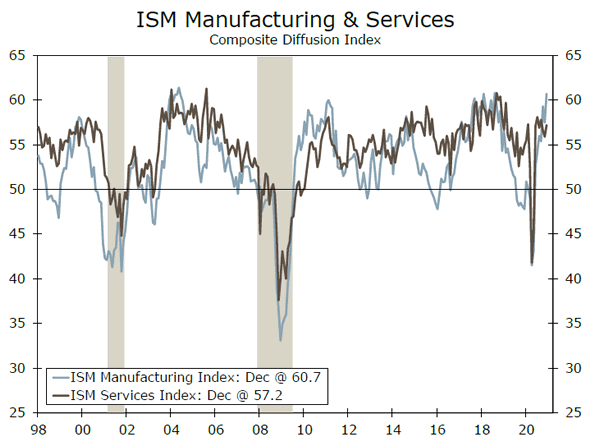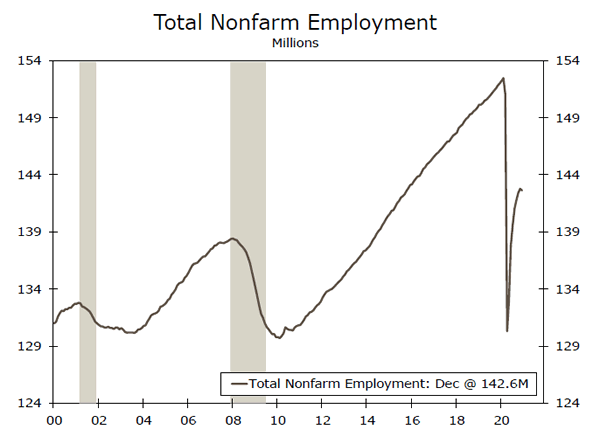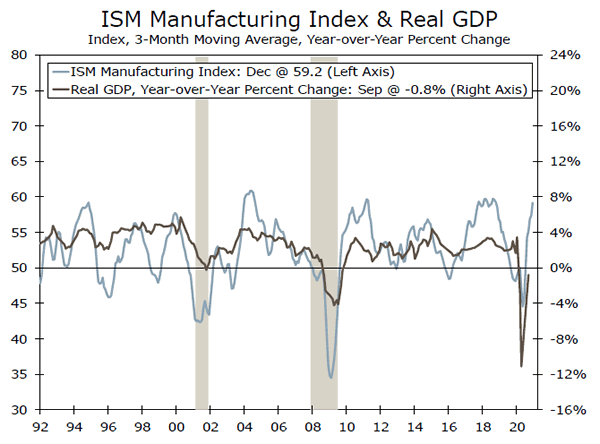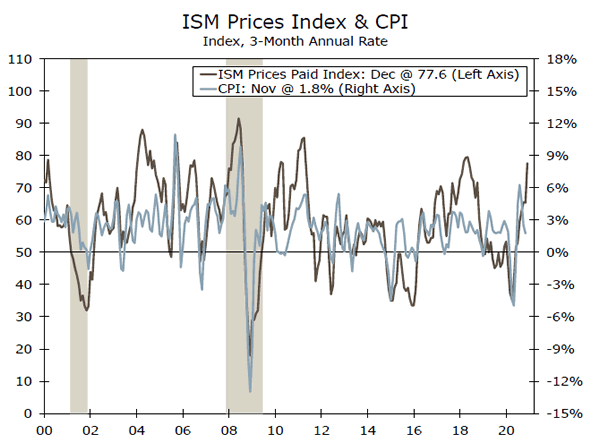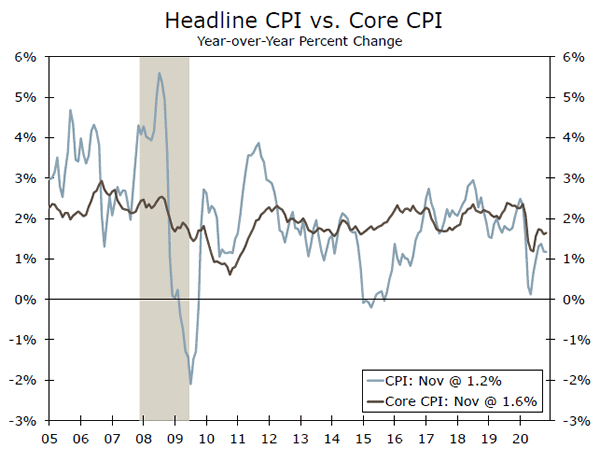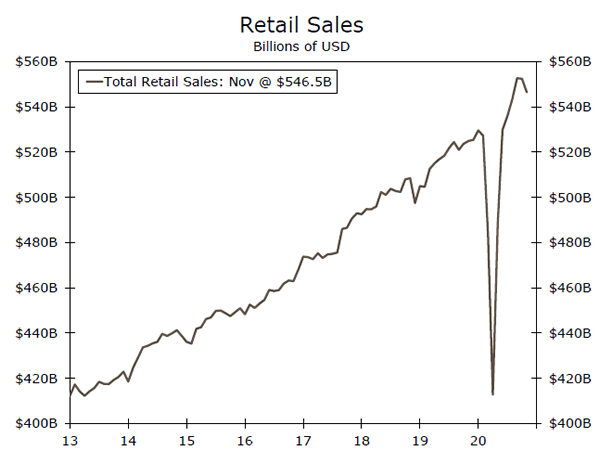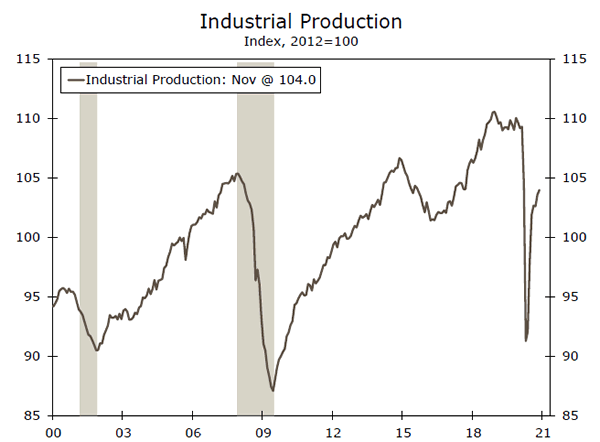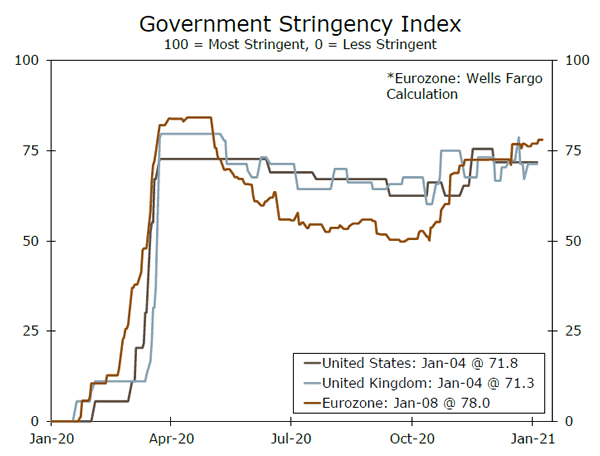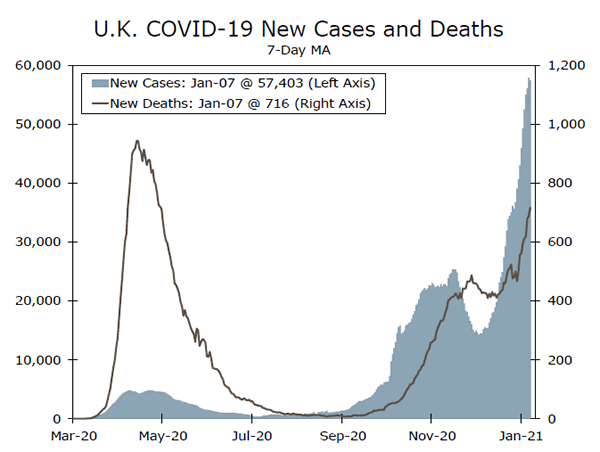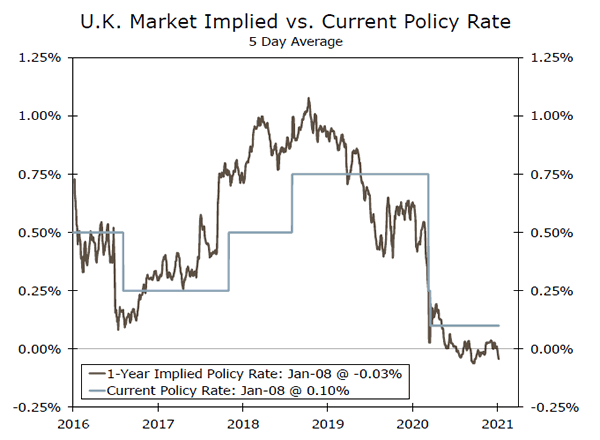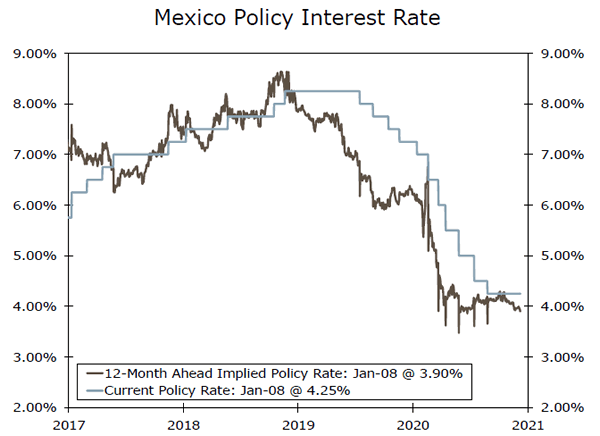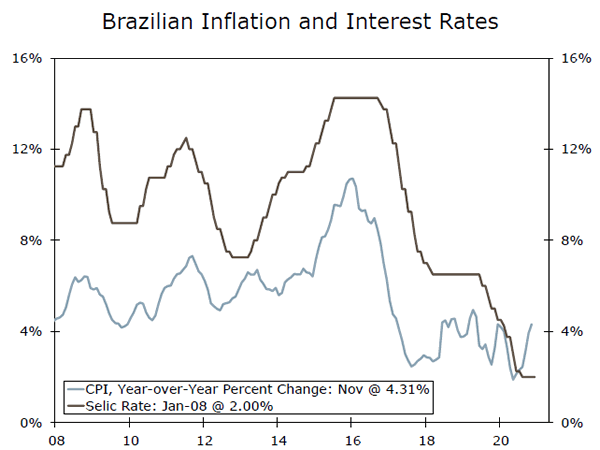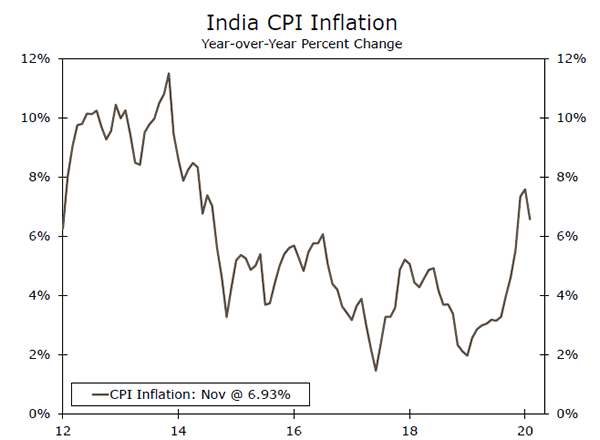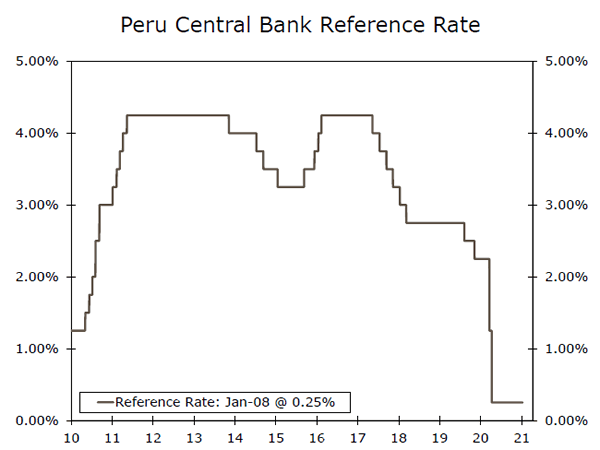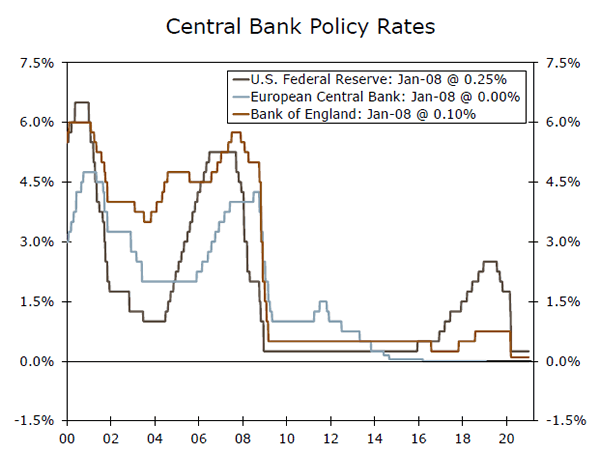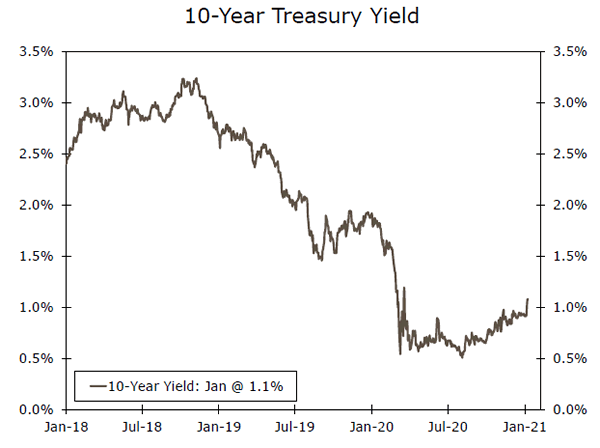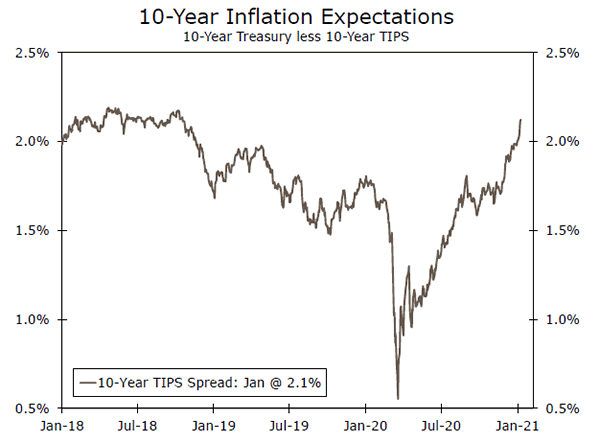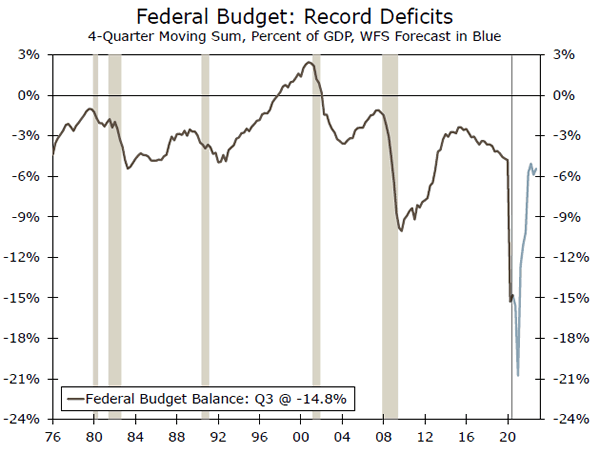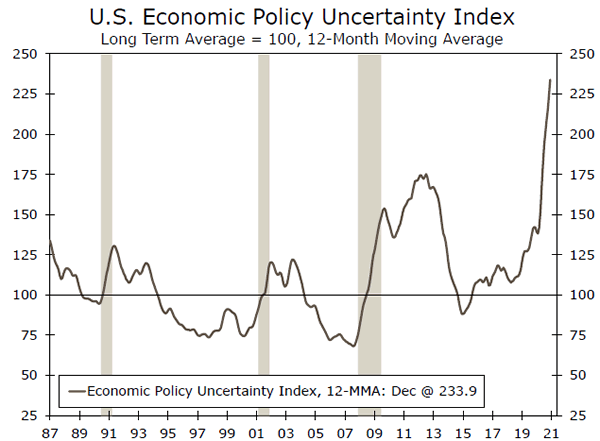U.S. Review
Slow Start to 2021
- The manufacturing sector is showing a great deal of resilience, with the ISM Manufacturing survey exceeding expectations, at 60.7, and factory orders remaining strong.
- The service sector is also showing a great deal of strength, although activity has clearly slowed in high-contact parts of the economy due to renewed operating restrictions.
- Nonfarm employment declined by 140,000 jobs in December. Private payrolls fell less, dropping by 95,000. Most of the drop was in the leisure & hospitality sector. The unemployment rate was unchanged at 6.7%.
Stimulus Should Bolster the Economy’s Resilience
The resurgence in COVID cases and slower rollout of vaccinations across much of the country has caused economic activity to pull back in recent weeks. Nonfarm employment fell by 140,000 in December, following a 336,000-job gain in November. Most of that drop was in the leisure & hospitality sector, which lost 498,000 jobs as the resurgence of COVID caused consumers to pull back from high-contact activities. Renewed lockdowns and operating restrictions also took a toll on employment. Government payrolls declined by 45,000 and there was also a 62,500-job loss in private education. The drop in overall payrolls helps validate the call for additional stimulus heard late in 2020 and should also help bolster calls for additional stimulus in the early days of the Biden administration. Nonfarm employment remains 9.8 million jobs below its February 2020 level.
While nonfarm payrolls fell, the report was not as weak as the headline suggests. Construction remains exceptionally strong and the industry added 51,000 jobs in December, with large gains in both the residential and commercial categories. The gain was helped by unseasonably mild December weather. Manufacturing added 38,000 jobs. The factory sector is proving resilient in the face of the latest COVID wave due to the need to replenish severely depleted inventories. Hiring also perked up in professional & business services, led by large gains in temporary staffing and professional & technical services. Hiring in retailing also topped expectations, with 120,500 jobs added in December, and payrolls rose by 46,600 jobs in transportation & warehousing.
Manufacturing is showing a great deal of resilience but December’s blowout ISM report overstates the strength in that sector. The ISM Manufacturing survey jumped 3.2 points in December to 60.7, which is the highest reading in two-and-a-half years for this highly reliably coincident series. Our middle chart shows the relationship between the ISM Manufacturing Index and the year-over-year change in real GDP, which looks quite encouraging. Quite a bit of December’s gain, however, was due to a 5.9-point surge in the supplier delivery series, reflecting lengthening delivery times stemming from lockdowns, operating restrictions and hiring difficulties tied to resurgence in COVID infections. New orders, production, order backlogs and employment all posted solid gains as well, indicating that the manufacturing sector will likely hold up well even if consumer spending hits a lull this winter.
Another aspect of the ISM survey that moved the markets this past week was the surge in the prices paid series to a near-decade high. The surge reflects a rebound in commodity prices, most notably oil, as well as reviving demand from China and some other east Asian nations. The weaker dollar is also boosting import prices, however, and spot shortage of goods and skilled workers are clearly showing up in selling prices. The jump has been enough to spur inflation concerns, with a growing number of forecasters beginning to see a faster rise back to the Fed’s 2% inflation target than previously thought. The revival in pricing power is good news for corporate profits, adding to the stock market’s torrid run, and also helping to pull long-term interest rates back above 1% this past week.
U.S. Outlook
Consumer Price Index (CPI) • Wednesday
Consumer prices likely continued to recover in December, with the CPI advancing 0.2%. Prices of discretionary items that saw large declines at the onset of the pandemic, like travel-related prices and apparel, should have continued to recover last month. But, a full rebound in many categories remains contingent on a considerable rise in demand, which we are unlikely to see until vaccination is widespread. Price expectations are also an important consideration in the outlook. Market-based expectations, measured by the 10-year breakeven rate, climbed to 2% this week. Consumer-based measures of expectations, however, still remain relatively subdued.
Inflation should gradually move higher this year, but remain tame. We do not expect inflation to meaningfully test the Fed’s new, higher tolerance level for some time. While discretionary services inflation is expected to strengthen, we expect some softening in core goods inflation despite recent dollar weakness.
Previous: 0.2% Wells Fargo: 0.3%
Consensus: 0.4% (Month-over-Month)
Retail Sales • Friday
Total retail sales are set to close out the year better than they started it, with our forecast for flat sales growth in December consistent with a 4% year-over-year gain. This remarkable feat cannot be said for many areas of the economy that continue to reel from the pandemic. But, retail has disproportionately benefited from a surge in goods spending. That said, there remains wide variation in sales by retailer, and we expect that these dynamics of varying sales continued last month amid rising virus case counts.
If sales come in weaker-than-expected, the pick-up in case counts may have dampened the end to the holiday season more than we had anticipated and may signal some coming payback in goods consumption. If sales exceed our expectations, however, it would be further support of our forecast that after a year defined by the virus, households spent in record numbers this holiday season as they yearned for comfort and normalcy.
Previous: -1.1% Wells Fargo: 0.0%
Consensus: 0.0% (Month-over-Month)
Industrial Production • Friday
Industrial production remains off its pre-virus peak but has recovered more than half of its virus-related losses. The bulk of the rebound has to do with the manufacturing sector, which continues to benefit from the pandemic-induced shift toward goods spending. Manufacturing activity appears to have held up in December. The manufacturing sector added 38K net new jobs last month, and the ISM manufacturing index jumped to 60.7, just shy of its prior cycle peak reached in mid-2018. Continued strength in the sector should keep manufacturing humming in December. As such, we forecast another solid monthly increase of 0.3% in December. If production stumbles, however, it may reflect a sputtering in some manufacturing categories that have outperformed in recent months like consumer goods. That said, the ongoing need to rebuild inventories following supply chain disruptions, bodes well for the near-term outlook for manufacturing activity more generally.
Previous: 0.4% Wells Fargo: 0.3%
Consensus: 0.5% (Month-over-Month)
Global Review
U.K. Enters New Lockdown
- On Monday morning, U.K. Prime Minister Boris Johnson announced a new nationwide lockdown in an effort to contain the spread of COVID. With the U.K. economy already struggling to gather momentum amid already imposed restrictions and Brexit uncertainties, a nationwide lockdown introduces more downside risk to the local economic recovery.
Inflation Eases in Mexico
- CPI inflation has been stubbornly high in Mexico; however, data released this week indicate price pressure may be starting to ease. With inflation now in the central bank’s target range, additional policy rate cuts could be imminent.
United Kingdom in Lockdown Again
In prior weekly economic commentary reports, we have highlighted the United Kingdom’s struggles with containing COVID. Over the past few months, confirmed cases numbers have risen and hospital capacity continues to be tested. With a new strain of the virus making its way across London and the rest of the country, policymakers have instituted new lockdown measures and have tightened restrictions in an effort to slow the spread of COVID. Earlier this week, Prime Minister Boris Johnson took restrictions to new heights, imposing nationwide lockdowns as the new variant of COVID has been deemed more transmissible and “out of control.” The new restrictions include closing all schools across the country as well as a stay-at-home mandate for all U.K. citizens with only limited exceptions. As of now, the nationwide lockdown is set to remain in place until mid-February; however, Boris Johnson has stated the lockdown could be extended if COVID does not come under control and hospitals remain overwhelmed.
New restrictions will most likely come with a renewed downturn in economic activity. Mobility across the country will likely be suppressed and consumer spending should be affected as well. These disruptions complicate the U.K.’s economic recovery from COVID and could lead to a contraction in Q1-2021 in addition to an economic decline in Q4-2020. Up to this point, the policy response has been swift. The U.K. government has deployed fiscal resources to help households and businesses to offset the economic impact of the virus. In addition, the Bank of England (BoE) has cut policy rates effectively down to 0%, while it has also resumed asset purchases under a quantitative easing program. As the virus rages across the U.K., the burden could be placed back on the government and central bank to provide more support to the economy. This week, central bank officials signaled serious discussions of the implications of negative policy rates were under way. As of now, we do not expect the BoE to take interest rates into negative territory; however, we acknowledge the risk of negative rates are increasing.
Door Opening for Another Rate Cut in Mexico
This week, CPI inflation data released indicate price growth is beginning to slow in Mexico. In December, inflation slowed to 3.15% year-over-year, falling back in line with the Central Bank of Mexico’s CPI target. The central bank’s past few meetings have been defined by policymakers highlighting the rise in inflation as rationale to keep policy rates on hold. With inflation falling back toward target, monetary policymakers in Mexico could have new justification for another 25 bps rate cut in early 2021. In addition to falling inflation, the central bank’s monetary policy rate setters has arguably turned more dovish. This year marks some turnover to the monetary policy committee members, with historical commentary from new members suggesting rate cuts could be likely in early 2021. Markets have also started to price in rate cuts as well. As of now, market participants believe one 25 bps rate cut is likely in the first three months of 2021, and with the fall in inflation and dovish turn in policymakers, we forecast a 25 bps rate cut in take place in the first quarter of this year.
Global Outlook
Brazil Inflation • Tuesday
Next week, December IPCA inflation will be released in Brazil, with consensus forecasts calling for prices to rise 4.4% year-over-year. Brazilian inflation has been steadily rising since May as the combination of lower interest rates, elevated fiscal spending and a weaker exchange rate have contributed to inflationary pressures. Of those three variables, elevated fiscal spending has likely contributed to rising inflation the most. The Bolsonaro administration has moved forward with aggressive fiscal stimulus, including direct payments to households. Fiscal support has pulled many households out of poverty, while improved household balance sheets have increased demand for goods and services across the country. Just this week, a former Brazilian central banker noted that without fiscal austerity Brazil runs the risk of losing control of inflation. In our view, should inflation continue to rise and the economy gradually improve, the BCB will likely entertain rate hikes in 2021.
Previous: 4.31%
Consensus: 4.40% (Year-over-Year)
India Inflation • Tuesday
CPI inflation in India has been persistently high through most of the pandemic. We can point to supply chain disruptions and elevated food prices for the rise in prices; however, Reserve Bank of India (RBI) policymakers have consistently highlighted how these issues are temporary and only transitory in nature. According to consensus forecasts, December may be the month where some of these transitory issues causing inflation to stay above the central bank’s target begin to dissipate as forecasters look for inflation to drop to 5.0% year-over-year from 6.9% in November. Stubbornly high inflation has been the main justification for the RBI to keep policy rates on hold over the past few months. Inflation falling back toward 5% could give the central bank some space to resume its monetary easing cycle again in 2021. In our view, it will take a sustained fall in CPI for the RBI to cut rates; however, we believe inflation will drop enough to where the RBI can cut 25 bps in Q1-2021.
Previous: 6.9%
Consensus: 5.0% (Year-over-Year)
Central Bank of Peru • Thursday
The Central Bank of Peru will meet toward the end of next week to assess monetary policy for the first time in 2021. Over the course of 2020, Peruvian monetary policymakers cut the reference rate 200 bps to 0.25% as COVID disrupted the economy. On a per capita basis, Peru experienced the most COVID-related fatalities of any country, and could experience one of the sharpest 2020 GDP declines in the emerging markets. While we do not expect any major policy decisions next week, 2021 could be another year of sluggish growth in Peru. COVID cases are still rising and political risk is more elevated following the resignation of multiple presidents last year. While not our base case scenario for the country, it is possible more political turmoil results in capital flight out of Peru and the currency comes under renewed pressure. We have already seen the central bank intervene in FX markets to stabilize the sol and could discuss policy response options to elevated volatility at next week’s meeting.
Previous: 0.25%
Consensus: 0.25%
Point of View
Interest Rate Watch
Long-term Rates Trending Higher
The yield on the benchmark 10-year Treasury security, which has been trending higher since late summer, breached 1.00% this week for the first time since the financial market volatility associated with the onset of the pandemic in March (middle chart). Furthermore, most of this increase in recent months seems to reflect expectations of modestly higher inflation in coming years. As shown in the bottom chart, the spread between the 10-year note and the 10-year inflation protected note, which is a measure of inflation expectations, has trended up more than 2% at present from roughly 50 bps in mid-March. This spread between these two Treasury notes suggests that market participants currently expect inflation to average roughly 2% per annum over the next 10 years.
Are officials at the Federal Reserve alarmed by the recent rise in long-term interest rates? Probably not, at least not yet. In some sense, Fed policymakers likely are pleased by recent developments. After all, the FOMC is attempting to engineer a slightly higher inflation rate than the sub-2% rate that has prevailed in recent years. Given the strong association between inflation expectations and the actual rate of inflation, the rise in the former may lead to a slightly higher rate of actual inflation in coming months and years. Furthermore, the modest increase in long-term interest rates in recent months—they remain incredibly low in an absolute sense—will hardly bring the economy to its knees.
That said, Fed officials could become more concerned if long-term interest rates were to snap significantly higher, especially if that move was not associated with stronger economic data. The recently released minutes of the December 15-16 FOMC meeting show that most committee members view the current pace of Fed asset purchases as being appropriate. But, there was also an acknowledgement that the Fed could step up its pace of purchases and/or change the composition, so that more longer-dated notes and bonds are purchased. In sum, we look for long-term rates to trend higher in coming months, but not to snap up.
Credit Market Insights
Further Aid, Not a Moment Too Soon
The signing of the new COVID relief bill over the holidays (Dec. 27) revamped small business aid heading into 2021. The Paycheck Protection Program (PPP), which initially expired August 8, was allotted $285B in additional funding, while the Economic Injury Disaster Loan (EIDL) program received $20B. Further relief to both U.S. Small Business Administration (SBA) programs comes as welcome news to cash strapped small businesses. That said, several provisions differentiate this “second round” of the PPP from the first. Notably, the maximum withdrawal amount is now capped at $2M, whereas the initial program set the amount at $10M per business. To target smaller businesses that were the most heavily affected, only businesses with 300 or fewer employees will be considered (original PPP set this at 500), and evidence must be presented that shows a significant (25% or more) reduction in gross receipts in any 2020 quarter over its 2019 equivalent.
November’s decline in the NFIB small business optimism index following the U.S. presidential election hinted at waning confidence, but the news of additional stimulus should help raise optimism among small business owners who were in dire need of extra support. A December report released by the NFIB research center indicated that 91% of PPP borrowers spent their entire loan amount, and one-in-four small businesses would have to shutter in the next six months without improved economic conditions. The stimulus package’s additional loan options may have helped just in the nick of time.
Topic of the Week
Democrats Have Another Strong Showing in GA
This week’s rare double-barreled Senate election in Georgia was a high-stakes contest for control of the U.S. Senate. Going into the race, Republicans held 50 Senate seats to the Democrats’ 48. As of this writing, the Democrats appear to have won both seats as the Associated Press has called the two races in favor of Democratic candidates Raphael Warnock and Jon Ossoff.
If these results hold, Democrats would obtain unified control of the House, Senate and White House for the first time since 2009-2010. Their majorities in both chambers, however, would be razor thin. In the House, Democrats would hold just a four seat majority, while in the Senate it would be a 50-50 tie, with the tie broken by Vice President Kamala Harris.
Does this mean that Biden’s policy platform would be enacted verbatim? Probably not. First, intraparty squabbles can squash legislation, as was the case when Republicans failed to fully repeal the Affordable Care Act in 2017. It would take just one Democratic Senator or a handful of Democratic House members to defect and sink a bill if Republicans held together.
Second, the 60-vote filibuster threshold in the Senate looms large. As an example, another COVID fiscal relief deal would require 10 Republicans to join the 50 Democrats to end a Senate filibuster. This is of course possible, but the need to attract numerous members from the other side of the aisle could limit the size of the bill, particularly given that a roughly $900 billion package was already signed into law at the end of 2020. Eliminating the filibuster is possible but unlikely in our view, as both moderate Democrats and Republicans have expressed skepticism about the idea.
Bottom line: Democrats securing both Georgia Senate seats creates the circumstances under which some of Biden’s economic policy platform could become law, but it would likely be a significantly scaled-back version.




